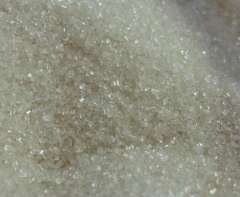Sugar (raw and refined)
| Infobox on Sugar (raw and refined) | |
|---|---|
| Example of Sugar (raw and refined) |  |
| Facts | |
| Origin | This table shows only a selection of the most important countries of origin and should not be thought of as exhaustive:
|
| Stowage factor (in m3/t) |
|
| Angle of repose |
|
| Humidity / moisture |
|
| Oil content | - |
| Ventilation | - |
| Risk factors | Unextinguished cigarette ends may cause sugar fires, which are greatly feared because they are difficult to extinguish. Ash acts as a catalyst in combustion. Sugar fires are extinguished with CO2 or chemical extinguishing agents. Raw sugar is highly sensitive to any foreign odors and should thus not be stored together with odor-emitting products. Raw sugar is sensitive to dust, dirt, fats and oils. When exposed to moisture, raw sugar has a tendency to grow mold and form syrup. It may also suffer depreciation as the result of infestation by rats, mice, ants, flies and silverfish. |
Sugar (raw and refined)
Contents
Description
Sugar is the generalised name for a class of sweet-flavored substances used as food. They are carbohydrates and as this name implies, are composed of carbon, hydrogen and oxygen. There are various types of sugar derived from different sources. Simple sugars are called monosaccharides and include glucose, fructose and galactose. The table or granulated sugar most customarily used as food is sucrose, a disaccharide. Other disaccharides include maltose and lactose.
Sugars are found in the tissues of most plants but are only present in sufficient concentrations for efficient extraction in sugarcane and sugar beet. Sugarcane is a giant grass and has been cultivated in tropical climates in the Far East since ancient times. A great expansion in its production took place in the 18th century with the setting up of sugar plantations in the West Indies and Americas. This was the first time that sugar became available to the common people who had previously had to rely on honey to sweeten foods. Sugar beet is a root crop and is cultivated in cooler climates and became a major source of sugar in the 19th century when methods for extracting the sugar became available.
Sugarcane (Saccharum spp.) is cultivated in tropical and sub-tropical regions for the sucrose that is found in its stems. It requires a frost-free climate with sufficient rainfall during the growing season to make full use of the plant's great growth potential. The crop is harvested mechanically or by hand, chopped into lengths and conveyed rapidly to the processing plant. Here it is either milled and the juice extracted with water or the sugar is extracted by diffusion. The juice is then clarified with lime and heated to kill enzymes. The resulting thin syrup is then concentrated in a series of evaporators and then further water is removed by evaporation in vacuum containers. The resulting supersaturated solution is seeded with sugar crystals and the sugar crystallizes out and is separated from the fluid and dried. Molasses is a by-product of the process and the fibre from the stems, known as bagasse, is burned to provide energy for the boiling of the syrup. The crystals of raw sugar have a sticky brown coating and can either be used as they are or can be bleached by sulphur dioxide or treated in a carbonation process to produce a whiter product.
Sugar beet (Beta vulgaris) is a tuberous root which contains a high proportion of sucrose. It is cultivated in temperate regions with adequate rainfall and requires a fertile soil. The crop is harvested mechanically in the autumn and the crown of leaves and excess soil removed. The roots do not deteriorate rapidly and may be left in a clamp in the field for some weeks before being transported to the processing plant. Here the crop is washed and sliced and the sugar extracted by diffusion. The raw juice is then treated with lime and carbonated in a number of stages in order to purify it. Water is evaporated by boiling the syrup under a vacuum. The syrup is then cooled and seeded with sugar crystals. The white sugar which crystallizes out can be separated in a centrifuge and dried. It requires no further refining.











